Sunday, 16 July, 2017 by Beachbums1

Baby Elephant attempting to give Mama a drink from the riverbed. The water level is high so the elephants don’t have to dig too deep to get fresh water.
A little over six weeks ago, we drove out of Umlani Bush Camp and made our way back to Johannesburg. We had a plane heading for London to catch the next day. Not going to lie, both my daughter and I had a tear in our eye as we left the magical Timbavati Private Reserve. This safari was everything I dreamed it would be but I was also sad/angry that a lot of the animals are at risk from poachers. Thankfully, there are those willing to fight against them but it seems like a losing battle sometimes. As with drugs, the demand for animal parts needs to be stopped but oh, what a complicated weave that is.
There were so many wonderful memories from our nine days there and below is a recap in photos. My heart is happy when I look at them…

The lilac-breasted roller in South Africa.
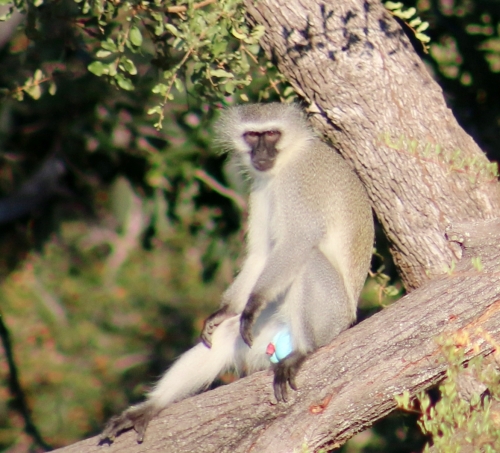
Vervet Monkey, males are known for their bright blue scrotum and vivid red penis. They have a complicated vocal communication system. For example, one screech will indicate a predatory bird and all the vervets will scan the sky. Likewise, a snake call will have all looking at the ground.
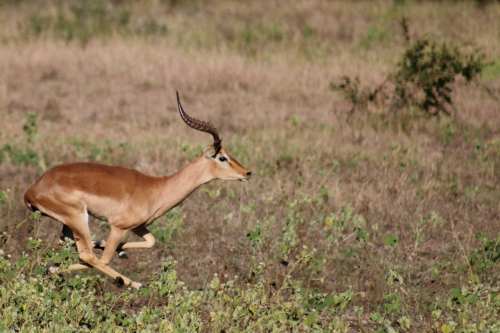
The Steenbok is a small, brown antelope. Females don’t have horns. They zig-zag as they run when avoiding a predator.

Always a thrill to see Giraffes ~ they are such interesting creatures. Where there are giraffes, there are usually zebras. And like the zebra stripes, the brown and white pattern on the giraffe is unique to each individual. These are males because their stumps are bald. The females are tufts.

Sunset in South Africa
If you’d like to see additional safari photos, follow along on instagram @beachbums88
Posted in Africa, Animals, Photography, South Africa, Timbavati, Travels, Wildlife | Tagged Elephant, Giraffe, Photography, Safari, South Africa, Travel, vervet, Wildlife | 24 Comments »
Sunday, 11 June, 2017 by Beachbums1
Of all the animals we saw on safari, the leopard was the most beautiful and my favorite to watch prowl. They are graceful creatures, with stunningly intense gazes. Their eyes are amazing to watch as they stare at either food or foe.
Leopards prefer hiding in the bush and are so stealth, we considered ourselves very lucky to have experienced seven different leopard sightings during our nine-day stay in the Timbavati. On our first early morning drive, Cabinet, the Umlani tracker, pointed to a female leopard hiding in a bushy area staring intently in one direction:

She still had blood on her long beautiful whiskers which indicated a fresh kill. As we drove around the corner to see if we could get a better view of her, we saw what held her impenetrable gaze:


A one-eye blind hyena was munching away on her recently killed impala. She was waiting to see if she could steal it back. Michael, our Wildeye Photographic guide, explained that hyenas are much stronger than the leopard, higher on the food chain and frequently steal their kills. Leopards attempt to get their meals into a tree and out of the reach of hyenas but this hyena was too quick for her.
As we watched the Hyena and Leopard, our Umlani guide said “Look, Ellies” ~ we turned around to see a large herd of elephants moving up to the waterhole. I was astounded that this was what we were witnessing on our first morning out. Absolutely amazing!!

All creatures in the bush give a respectful wide berth to the elephants. No one wants to be on the receiving end of a elephant tusk or foot. As the herd came in, the leopard watched closely to see if the hyena would scurry away but unfortunately for her, he confronted her. She’s a little hard to see in the following video but look to the left ~ she’s snarling in the bush. Her growl was enough to get the hyena to leave her alone
Any leopard sighting is thrilling because they are so secretive and prefer to stay undercover.
Our last morning drive we saw the same beautiful female leopard with a recently-killed grey duiker. We came full circle with her and I was pleased she finally got to eat the meal she caught.

Female leopard with bloodied nose from eating a grey duiker

Posted in Africa, Photography, Safari, South Africa, Timbavati, Travels, Wildlife | Tagged Elephant, Grey Duiker, Hyena, Impala, Leopard, Safari, South Africa, Wildlife | 11 Comments »
Tuesday, 6 June, 2017 by Beachbums1
The term Big Five was originally coined by big game hunters but is now used by those wanting to see and photograph the following in South Africa: Elephant, Lion, Leopard, Rhinoceros and Cape Buffalo.
I went on safari without expectations of “must see” animals. But our guides were invaluable in finding us the Big Five within the first two days of our nine day safari. Michael from Wildeye, SA not only told us about animal behavior but could predict when they would get up, yawn, walk by us, etc. It helped a lot in capturing the animal’s behaviors. Always good to have a few seconds warning to get the camera ready when there might be only one chance to snap a photo.
A male leopard was the first of the Big Five we saw on our first drive out in the bush. Back at camp, before we started on the drive, some of the guests mentioned they had been waiting days for a leopard sighting. Guests on different vehicles would compare notes as to which animals had been spotted ~ reminded me of Apres Ski talk around the fire when skiers would brag about double-black diamonds & vertical feet. Except at Umlani. talk around the firepit is all about the animals!
We are all so excited when Shadrack pointed and said “leopard” ~

The rest of the Big Five were spotted numerous times over our nine day stay.
I’ve had some people question why I would spend the money traveling to a far-away country to see animals I can view at the zoo. Those are people who don’t know me well. I cry at zoos so I don’t go. The chance to view animals in their natural environment was priceless for me. The multiple sightings were fascinating because the behaviors changed each time. My idea of heaven on earth.
Here are some of our sightings of other Big Five:


Posted in Africa, Animals, Photography, South Africa, Travels, Wildlife | Tagged Cape Buffalo, Elephant, Leopard, Lions, Photography, Rhino, Safari, South Africa, Travel, WildEye Tours, Wildlife | 10 Comments »
Sunday, 4 June, 2017 by Beachbums1
As we drove through the gates into the Private Reserve, I had to pinch myself ~ it was the start of a safari trip I’d been planning for several months, and had been dreaming about for years!
Our driver asked what animal we were most interested in seeing during our nine day visit and my daughter immediately said “Giraffe.” No sooner had she said giraffe, we came around the corner and there was one munching on some leaves. It was a fabulous way to begin our wildlife adventures.

We arrived at Umlani Bushcamp and were greeted by Michael Laubscher from Wildeye .

He would be our photographic guide for the entire time we were at our Africa lodge. Unfortunately, I broke my wrist two weeks prior to going on safari, but both my husband and daughter jumped in with both feet (or should I say “with both hands”) and learned as much as they could about photography from Michael. We didn’t keep track of who took which photos so all photos will be considered “Team Beachbums.”
I’m so glad we chose to go with a Wildeye private- guided safari. I knew personalities would be important and was relieved to find that Michael’s easy-going but professional style was perfect for us. Michael was a safari guide for many years before becoming a photographic guide and his ability to anticipate what an animal would do next was invaluable to getting the perfect photo.
The Bush Camp provided a private guide/driver (Shadrack) and tracker (Cabinet) for the duration of our stay. They were both incredible and I’m still amazed how they were able to see small creatures, sometimes at night, while riding in a vehicle and the animal blending in with their surroundings. Truly amazing.

Cabinet explaining tracks

Cabinet and Shadrack checking on Leopard tracks
It was so nice to have a private vehicle so we could spend as much time as we wanted at a sighting rather than being in a vehicle with others who preferred to chase the next Big 5 animal sighting.
The camp we stayed at blends in with the environment and was made from natural materials in a traditional African style. There is no electricity in the thatched rooms but there are solar lights which are placed on the nightstands. All accommodations have en-suite facilities including their open-air bush showers. There is also complimentary bottled water. The outdoor bathroom took a little getting use to but it was nice to shower under the warmth of the sun.
The very first animal we saw on safari was a Jackal. Beautiful but quick…

…and then we saw our first of seven Leopard sightings. More on that next time.
Posted in Africa, Photography, Safari, South Africa, Timbavati, Travels, Wildlife | Tagged Bushcamp, Giraffe, Jackal, Photography, South Africa, Timbavati, Tracker, Travel, Umlani, WildEye Tours, Wildlife | 4 Comments »
Saturday, 22 April, 2017 by Beachbums1
I’M GOING ON A SAFARI!!!!
A little over a year or so ago, I read about Gerry Van der Walt from Wild Eye Photo Safaris as being the one to watch on Periscope for wildlife. I started watching him on safari tours and it was amazing to see the lions, hippos, elephants, rhinos, big cats, etc ~ and all of it was live. But I became “hooked” when I switched over to Snapchat which is my preferred forum for seeing all the wildlife updates. Gerry posted lots of the baby animals. Seriously, what’s cuter than those amazing strong animals as tiny (and not so tiny) babies. Cue: Heart Melting!!
Gerry and the rest of the Wild Eye team are very consistent with updating their social media, so much so that when Gerry went quiet for a few days ~ I became worried something happened on one of the safaris. Those animals do get close to the vehicles. Turns out, I missed the snap where he said he was going somewhere without wifi and he would be off-line.
The photos and snap stories are so amazing and I shared many of them with my husband and daughter. Through Gerry’s instagram account, I found a youth photographer, David whose award-winning photo is now on exhibit at the National Museum of Natural History’s Nature’s Best Photography Exhibit. If you’re in Washington, DC and have an interest in wildlife/photography, I highly recommend seeing the exhibit. The “Leopards” photo was taken while David was on a safari in the Timbavati Private Reserve.

Youth Photographer viewing “Youth Photographer” winners at the Museum of Natural History
I’ve dreamed about going on a safari ever since those Wild Kingdom TV shows back in the day. Whenever my husband and I discussed going, it always came down to time and money. Mostly money. It seemed out of our reach. And I’m not a fan of being on tour groups where I’m required to be around a lot of people and on their schedule. I was overwhelmed with the logistics, money and basic planning. I didn’t want to go on a trip of a lifetime and not enjoy it because I didn’t know what or where to go. It seemed too daunting to tackle.
Things changed this past fall when one day Gerry asked on Snapchat “What’s keeping YOU from going on a safari?” My first thought was “the logistics” and secondly, I thought about the cost. It must be common to everyone because he immediately addressed how Wild Eye can organize a tour based on a budget provided by the guest.
I took a chance and emailed my per-person budget along with possible dates. Gerry wrote back within hours and asked pertinent questions about my preferences: which were the top animals I wanted to see, luxury v. eco-lodge, and did I prefer to be with other people or on a private guide. A few days later, Gerry recommended we go on a privately guided safari in the Timbavati Private Preserve in South Africa with Michael from Wild-Eye. Having already seen David’s (youth photographer) great photos from Timbavati, I was sold.
Timbavati borders Kruger National Park and, because there are no fences, the animals go back and forth between the park and the preserve. Bottom line, we wouldn’t be going on this trip if I hadn’t stumbled onto Wild Eye through periscope. They’ve made it too easy to plan such a fabulous adventure.
More on the details of planning in my next post but if you want to follow Wild Eye to see their fabulous wildlife images, you have your pick of social media outlets:
- Gerry (Wild Eye founder) is on Instagram/Twitter/Snapchat as: Gerryvanderwalt
- Gerry’s The Wildlife Photography Podcast is on Itunes/Soundcloud
- Our guide is on Instagram and Snapchat as: Michael.Laubscher
- For additional info on Wild Eye click here
Posted in Animals, Photography, Safari, Travels, Wildlife | Tagged Adventure, Eco-lodge, Photography, Safari, South Africa, Timbavati, Travel, WildEye Tours, Wildlife | 11 Comments »
Wednesday, 12 April, 2017 by Beachbums1
A Big Island adventure not to be missed is going to the 13,796 foot Mauna Kea Summit which at night offers the clearest and most awe-inspiring views of the night skies to rival any on Earth. I spent a lot of my time at the summit looking around and thinking “what a fantastic world we live in and I wish everyone could participate in this experience.”

It’s not required to go with a tour group to the summit but because we didn’t rent a 4-wheel drive (required for the top part of the mountain), we decided to join a tour. We were very pleased with the knowledge and friendliness of our tour guide/driver from Hawaii Forest and Trail . The trip lasts anywhere from 7-8 hours ~ depending on weather conditions and travel time. Our trip was right around 7 hours.

Abandoned Humuula Sheep Station
A picnic dinner is served at the historic (abandoned) Humuula sheep station located at 7,000 feet (half way up the mountain) and allows people to acclimate to the higher elevation. Some people were affected and others not at all. Thankfully, we were in the not at all category.
Throughout the tour, our guide provided a lot of historic and cultural information. Because the temperatures and winds make it downright winter-like at the top, the tour company provides winter jackets.
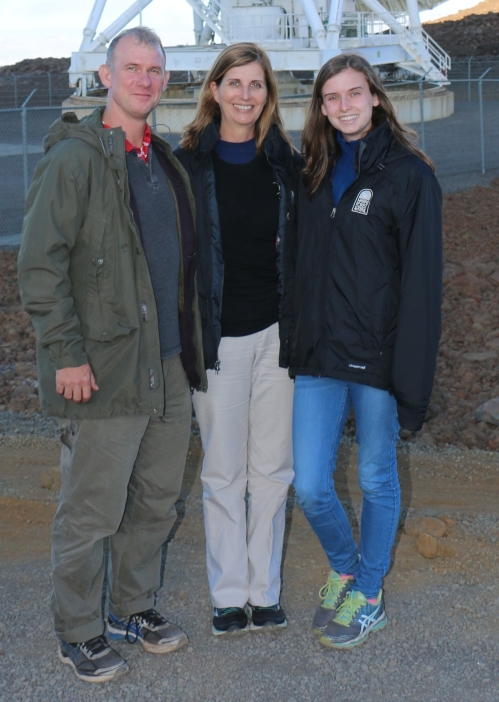
Thank goodness for the jackets provided by the tour company ~ definitely needed.
It was very interesting to be standing amongst the world’s largest collection of research telescopes.
The large dish-shaped structure is one of 10 very long Baseline Array radio telescopes that are spread out across the United States and used simultaneously. Astronomers use the telescope to make detailed studies of space objects. Each antenna is controlled remotely by the Array Operations Center in Socorro, New Mexico, but there are local site technicians at the Mauna Kea summit.

Most sacred part of Mauna Kea and off limits to visitors
The Hawaiians consider the mountain to be one the most sacred places in the islands and it is not without controversy that it is used commercially. There is an area of the mountain which is off-limits and I’m glad most people respect it.

A highlight was the spectacular sunset which looked like other-wordly to me especially when the sun was low and in the clouds far below us.

On the way down the mountain, we stopped at 9,000 feet for delicious hot chocolate and star-gazing and then we stopped at the visitor’s center for a bathroom break and a little shopping in the gift shop. Photos of stargazing will follow in a future post.
Before you attempt traveling to the summit, here are a few precautions: guests should be able to hike on uneven, rocky, wet, and sometimes muddy terrain. Because of high altitude, I would caution anyone who has respiratory, circulatory and /or heart conditions, pregnancy or generally in poor health. Scuba divers shouldn’t make the ascent within 48 hours of diving. Children under 16 are not allowed on the tour. Be sure to wear closed-toe shoes, long pants and a sweatshirt/sweater. Dressing in layers is best.
Interesting Facts about Mauna Kea:
- It is estimated to be approximately one million years old
- Last eruption was about 4,000 years ago
- It is a dormant volcano but could still erupt
- The area of Mauna Kea takes up about 28.8% of the island
- Mauna Kea means White Mountain
- Snow falls on both Mauna Kea and Mauna Loa
Posted in Big Island, Hawaii, Photography, Travels, USA | Tagged Altitude, Astronomy, Big Island, Hawaii, Mauna Kea, Photography, Sunset, Telescopes, Travels | 3 Comments »
Monday, 10 April, 2017 by Beachbums1

Early morning hike to Mau’umae Beach
Mau’umae Beach is my favorite on the Big Island (Hawaii). It’s secluded, sandy, and I can usually have it all to myself on a weekday if I get there early enough. The water is almost always calm so it’s a great place to snorkel. If you happen to be there during the winter months, keep a lookout for whales or dolphins just offshore.
Getting to Mau’umae Beach requires a short hike from Spencer Park or you can drive from the Mauna Kea Beach Hotel. If you’re coming from Mauna Kea Beach Hotel, you will need to get an access pass from the guard shack and they only give out 10 passes per day so go early. Once you have your pass, follow the road for approximately 300 yards and take the second right turn. Continue across two small wooden bridges until you arrive at the unpaved parking area above the beach. The trail down to Mau’umae Beach is marked by a sign.

HIking to Mau’umae Beach from Spencer Park

Along the Ala Kahakai Trail to Mau’umae Beach, Hawaii
From Spencer Park, park at the far left side of the parking lot and take the coastal path for about a quarter mile. Fishing is popular along the hike and the views of Mauna Loa are spectacular!

Along the trail to Mau’umae Beach, woman fishing and Mauna Loa in the background.
If you’re on the Big Island, I highly recommend you visit this small, secluded and beautiful beach.
Posted in Beach, Big Island, Hawaii, Hiking, Photography, Travels | Tagged Beach, Big Island, Fishing, Hawaii, hiking, Secluded | 3 Comments »
Sunday, 9 April, 2017 by Beachbums1
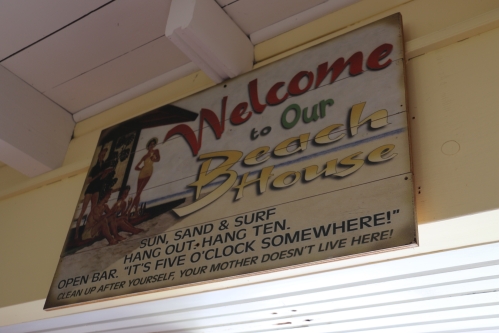
When I was younger, there was no question that I would stay with family and friends when ever I went back to the Big Island (Hawaii) for a visit. But with a family of my own now, and my desire for more privacy, I usually book several different places to stay. The island is big enough to warrant moving locations to be closer to either the volcano or the beaches.

Sunset view from 118 Puako Beach
On our July visit, I booked an AirBnB vacation home for the first time. I’m thrilled to say the seven night stay at a two-bedroom, two bath beach house in Puako was a big success with everyone.
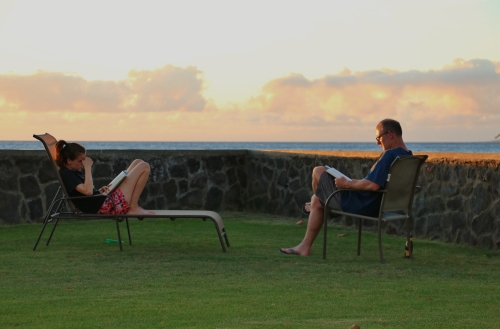
Waiting on Sunset in the Puako Beach House Yard
The location couldn’t have been better for us. We could see the ocean from the living room, patio and master bedroom. I love waking up to the sound of the waves crashing on shore. We were able to go to several beaches in close proximity to the rental home.

Bikes come with the Beach House rental
Upon arrival to the island, my brother loaded me up with all kinds of local foods for us to feast on while we stayed at the house. He thought of everything ~ fruits, main meals, coffee, desserts, vegetables, chips, etc. Yum! 118 Puako House came fully stocked with essentials so be sure to check in and then do your grocery shopping.

A Daily Visitor to the Beach House
Birds aren’t the only visitors to the beach house. Keep an eye out for unwelcome critters especially the dreaded centipede. They are red and nasty looking. Always check your shoes before you put them on and check your bed too. Anywhere they may hide ~ don’t come away with a painful bite.

If you book a home in Puako, be sure to rent one on the oceanside. The ocean breeze makes it much more comfortable during warmer days.
Posted in AirBnB, Big Island, Hawaii, Photography, Travels | Tagged AirBnB, Beach, Big Island, Bikes, Birds, Hawaii, Puako, Sunset | 5 Comments »
Saturday, 28 January, 2017 by Beachbums1
As a family, we’ve hiked in locations around the world and have been lucky enough to hike in Germany, Slovenia, Guam, Hawaii, Virginia, and many more. But I wasn’t surprised when my daughter deemed the Kīlauea Iki Trail on the Big Island as her all-time favorite hike. It’s a fascinating place located within the Volcanoes National Park on the Big Island of Hawaii. Kilauea remains an active volcano to this day.
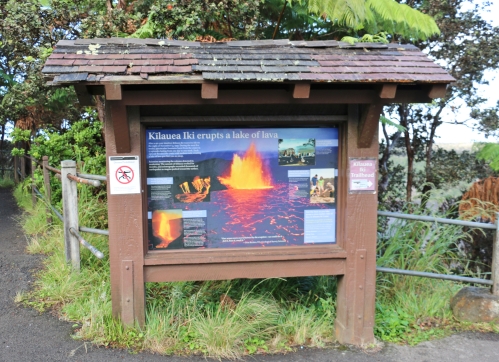
At the Kīlauea Iki sign, you can go in either direction but I would advise taking the trail to the right and hike counter-clockwise which will lead you through a rain forest, the 1959 lava lake, steam vents, cinder cones, and large fissures in the lava. Keep an eye out for the native nēnē (Hawaiian Goose) ~ we saw two but they were too fast to get a photo. The nēnē are the sixth most endangered waterfowl species in the world.
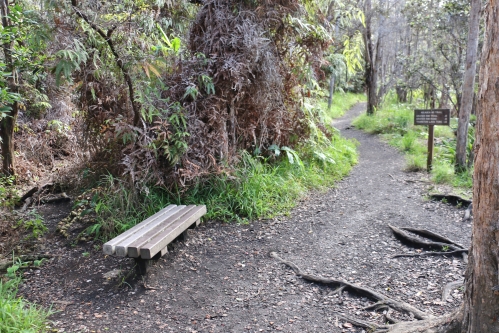

The rainforest section of the trail is well-worn but be careful with the rocks and occasional exposed roots. We started early in the morning and didn’t see anyone else until we got to the lava lake.

On hikes, my daughter only uses her phone to take photos but while we were on the trail, her college released the dorm assignments and she was excited to learn where she would be living for a year. Unfortunately, it wasn’t the dorm she preferred and it was the only sad part of the hike. But, fast-forward six months later, and she’s thrilled with her suitemates and her dorm.
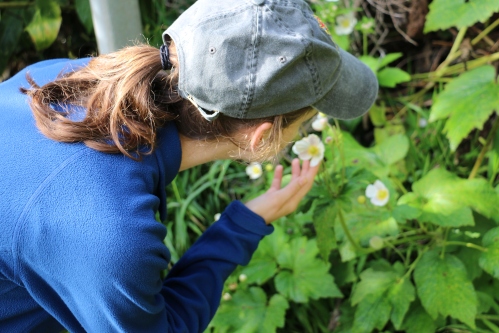

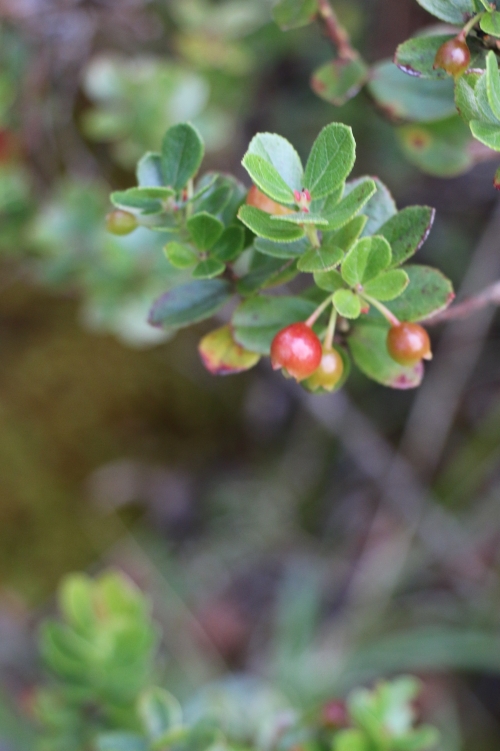
The ‘Ōhelo berries are a favorite treat for the nēnē and can be found throughout the trail. It is a hardy plant that even grows on the lava. The plant is a relative to the blueberries and the berry can range in color from dark red to pale yellow.

The amazing view from the rainforest.
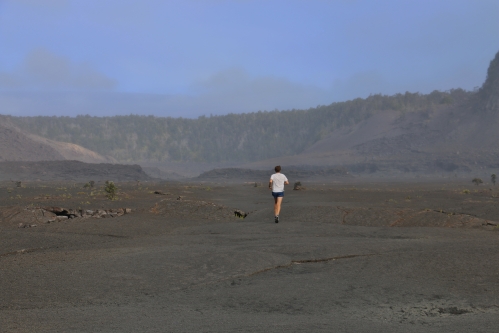
It was a little surreal to see a runner come through as we walked along the deserted and isolated lava crater but he obviously runs this trail frequently.

Be sure to follow the Ahu (stacked rocks) to find your way through to the other side of the trail. Please don’t disturb them!

If you go, here are a few words of advice:
- The trail is moderate to challenging. It’s steep and rocky. The descent/ascent is 400 feet (122m).
- It’s a 4-mile (6.4km) loop. It took us approximately 2.5 hours and we stopped for a snack.
- The trail head is 2 miles (3.2km) from the Visitor’s Center.
- Once you’re at the Kīlauea Iki parking lot (off of Crater Rim Drive), you may go either way from the trailhead. We preferred to go right which took us through the rainforest first then down to the crater floor.
- Be sure to bring water, food, hat, sunscreen, camera and rain gear. Be prepared for all types of weather conditions: hot, dry, wet, windy (!). Please remember to “leave only footprints” and bring all your trash and items back out of the area.
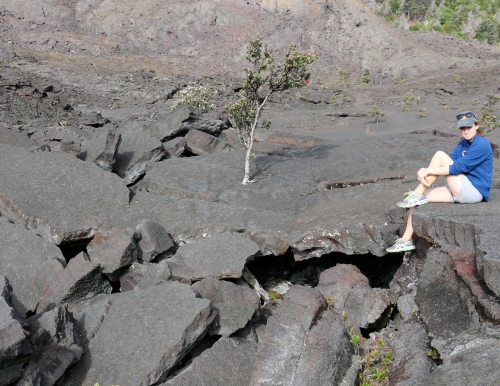
Posted in Big Island, Hawaii, Hiking, Islands, Photography, Travels, United States | Tagged Big Island, cinder cones, Hawaii, hiking, Islands, Lava, Photography, Rainforest, Travel, Volcano, Volcanoes National Park | 4 Comments »
Saturday, 22 October, 2016 by Beachbums1
I had the opportunity to leave the social media realm and see several of my favorite photographers’ works in the real world. It got me thinking about why I follow certain photographers out of the millions who are on social media.
As a wildlife fan, I find myself skimming instagram, twitter, wordpress and snapchat for all things wildlife and nature oriented. But there are only five photographers I follow daily ~ they bring an extra dash of joy to my life with their amazing skills and ability to capture the essence of majestic creatures. All five have one essential quality in common which is required for me to follow them; they are all conservationists.
My most recent follow is @Davidrphoto on Instagram. Of the photographers I follow, he is by far the youngest, currently a student at Stanford and his photos are from his trips to Africa. His “Youth Photographer of the Year” award-winning photo is currently on display at the National Museum of Natural History. The exhibit is titled: The 21st Annual Nature’s Best Photography Windland Smith Rice International Awards Smithsonian Exhibition. Windland Smith Rice was a nature photographer and conservationist.

The exhibition includes short videos with footage of the moments the photographer captures the award-winning photo. I was completely enthalled watching the videos and blown away by the amazing talent. I’m especially impressed with the profound patience they possess which is required to capture the perfect shot.

Video of the “Youth Photographer of the Year” winner David Rosenzweig
If you have an interest in photography, I highly recommend attending the free exhibit when you’re in Washington DC. The current exhibit will be on display until Sept 2017. The museum is located along the National Mall at 1000 Madison Drive NW. The closest metro stop is Archives/Navy Museum (Yellow Line).
There’s more information at the Museum of Natural History and you can view the photos on Facebook. I promise you the images are stunning in person and well worth the trip to the museum.

Award-Winning photos by Youth Photographers (under 18 years old)

Spotlight of Award Winning Photographers: Grand Prize: Daisy Gilardini. Top Row: Federico Veronesi, Matthew Polvorosa Kline, Denise Ippolito Second Row: Russ Bishop, Dee Ann Pederson, Cristobal Serramo Third Row: David Rosenzweig, J. Gregory Sherman, Karen Perry

Youth Photographer viewing “Youth Photographer” winners at the Museum of Natural History

Smithsonian’s Museum of Natural History ~ Exhibit Banners
Posted in Photography, Travels, USA, Washington DC | Tagged Awards, Nature's Best, Photography, Smithsonian, Social Media, Travel, Washington DC, Wildlife | 5 Comments »
Older Posts »








































































